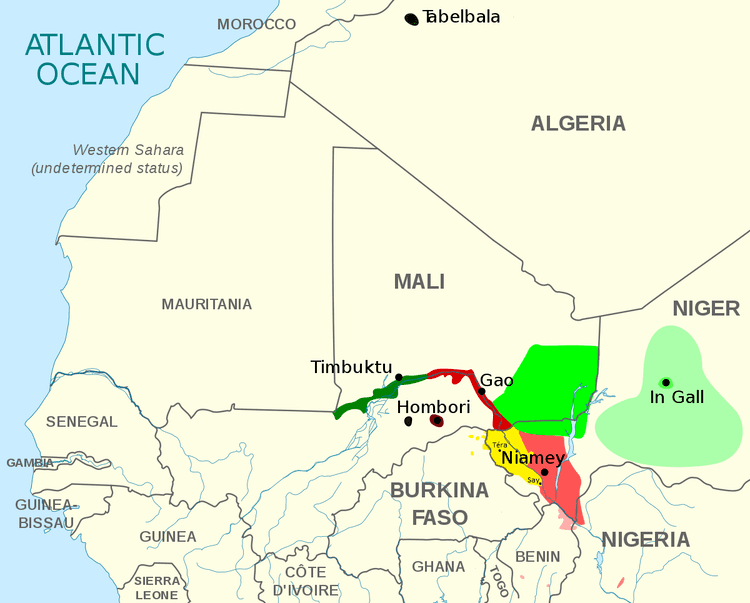Native to Algeria ISO 639-3 kcy | Native speakers 3,000 (2010) Glottolog kora1291 | |
 | ||
Language family Nilo-Saharan?SonghayNorthernKorandje | ||
Korandje (Kwaranje; kwạṛa n dzyəy, Arabic: البلبالية) is by far the most northerly of the Songhay languages. It is spoken around the oasis of Tabelbala by about 3000 people; its name literally means "village's language". While retaining a basically Songhay structure, it is extremely heavily influenced by Berber and Arabic; about 20% of the 100-word Swadesh list of basic vocabulary consists of loans from Arabic or Berber, and the proportion of the lexicon as a whole is considerably higher.
Contents
The only published studies of Korandje based on first-hand data are Cancel (1908), a 45-page article by a French lieutenant covering basic grammar and vocabulary and a couple of sample texts; Champault (1969), an anthropological study containing some incidental linguistically relevant materials such as sentences and rhymes; Tilmatine (1991, 1996), an article (published in German, then reworked in French) revisiting Cancel and Champault and adding about a page of new data recorded by the author; and Souag (2010a, 2010b), the former arguing the case for Western Berber loans in the lexicon, the latter studying the effect of contact with Berber and Arabic on its grammar.
Sounds
No complete phonological study of Korandje, systematically justified by minimal pairs, has yet been made. According to Souag (2010), the vowel system consists of lax ə, ŭ [ʊ], ə̣̣ [ʌ] and tense a [a], i, u, ạ [ɑ], ụ [o], while the consonant system is as follows:
Items in brackets are not normally used by older speakers. A bilabial click is attested in one baby-talk word.
An earlier proposal by Nicolaï (1981), based on a very limited corpus of recordings provided by Champault, suggested a smaller phoneme inventory:
alongside pharyngealized consonants ṭ ḍ ṣ ẓ ṇ ḥ as well as x q, found mainly in loanwords, and a six-vowel system: a, i, u, e, o, and ə (schwa).
Pronouns
The pronouns are: aγəy, I; ni, you; ana, he/she/it; yayu, we; ndzyu, you (plural); ini, they. Possessive forms are ʕan, my; nən, your; an, his/her/its; yan, our; ndzən, your (pl.); in, their. Subject agreement prefixes on the verb are ʕa- I; n-, you; a-, he/she/it; ya-, we; ndz-, you (plural); i-, they.
Verbs
The infinitive and singular imperative are both the stem (e.g. kani "sleep"); the plural imperative takes a prefix wə- (wə-kkani "sleep! (pl.)"). Cancel describes the conjugations as follows (also for xani):
According to Tilmatine, verbs are negated by surrounding them with `as ... hé/hi, e.g. ni `as ba enγa hé > n`esbanγa hé "do not eat!". "No" is hoho or ho: n'd'xani bînu, willa ho? "did you sleep yesterday, or not?".
Nouns
The most productive plural marker is the clitic =yu, e.g. tsəksi "goat" > tsəks=yu "goats". This marker comes at the end of the "core noun phrase", the unit consisting of noun+numeral+adjective+demonstrative: e.g. ạḍṛạ inẓa bya=γ=yu (mountain three big=DEM=PL) "these three big mountains". Some Berber loans retain versions of their original plurals, usually with the circumfix (ts)i-...-ən, e.g. awṛəẓ "heel" > iwṛạẓən "heels"; while the morphemes involved are clearly of Berber origin, the details of this system differ from any one attested Berber language, and this plural is extended to at least one item of Songhay origin, tsạṛə̣w "spoon" > tsiṛạwən. Some Arabic loans similarly retain Arabic plurals.
The possessive is expressed by the particle n, with the possessor preceding the possessed: wi n tsə̣ffạ "woman 's knife".
Numbers
The only non-Arabic numbers in normal use are a-ffu "one", inka "two", and inẓa "three". There also exist "cryptic" (argot) and children's counting systems. The syntax of numerals in the noun phrases is complicated.
